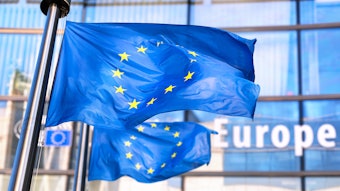This column is the last in a three- part series on the European Union’s (EU) Regulation No. 1223/2009,1 which was published on Dec. 22, 2009. This series began in the August 2010 issue of Cosmetics & Toiletries magazine with a focus on the regulation’s cosmetic safety reports,2 followed by a January 2011 column reviewing its additional changes,3 save for the Responsible Person’s (RP) obligations. The RP’s role is so complex that it warrants its own column, which is presented here.
Log in to view the full article
This column is the last in a three- part series on the European Union’s (EU) Regulation No. 1223/2009,1 which was published on Dec. 22, 2009. This series began in the August 2010 issue of Cosmetics & Toiletries magazine with a focus on the regulation’s cosmetic safety reports,2 followed by a January 2011 column reviewing its additional changes,3 save for the Responsible Person’s (RP) obligations. The RP’s role is so complex that it warrants its own column, which is presented here.
The concept of the RP is not new, as Japan established this concept in 2002 (effective 2005) for cosmetics, drugs, quasi-drugs and medical devices. Based on Japanese regulations, the RP must be located in Japan and is responsible for ensuring that all cosmetics comply with regulations; the EU has taken a similar approach to ensure total compliance with its new regulation.
When lecturing about the RP, this author often addresses the same unanswered question: Is the RP a single human being or a corporate entity? The present column will first review text within the regulation to answer this and many other questions specific to the RP. Following citations from the regulation, the author provides a recap of what duties are outlined for the RP in the text presented, as well as a discusses the implications.
RP Citations
To begin, Part 11 of the new regulation justification states: In order to establish clear responsibilities, each cosmetic product should be linked to a responsible person established within the Community. Part 13 additionally requires it necessary to determine the conditions under which a distributor can be considered the RP. Further, within Chapter II: Safety, Responsibility, Free Movement, Articles 4-7, detailed here, discuss the RP, including definitions, obligations, distributor considerations and identifications within the supply chain.
Article 4: Responsible person
1. Only cosmetic products for which a legal or natural person is designated within the Community as ‘responsible person’ shall be placed on the market.
2. For each cosmetic product placed on the market, the responsible person shall ensure compliance with the relevant obligations set out in this Regulation.
3. For a cosmetic product manufactured within the Community, and not subsequently exported and imported back into the Community, the manufacturer established within the Community shall be the responsible person. The manufacturer may designate, by written mandate, a person established within the Community as the responsible person who shall accept in writing.
4. Where, for a cosmetic product manufactured within the Community, and not subsequently exported and imported back into the Community, the manufacturer is established outside the Community, he shall designate, by written mandate, a person established within the Community as the responsible person who shall accept in writing.
5. For an imported cosmetic product, each importer shall be the responsible person for the specific cosmetic product he places on the market. The importer may, by written mandate, designate a person established within the Community as the responsible person who shall accept in writing.
6. The distributor shall be the responsible person where he places a cosmetic product on the market under his name or trademark or modifies a product already placed on the market in such a way that compliance with the applicable requirements may be affected. The translation of information relating to a cosmetic product already placed on the market shall not be considered as a modification of that product of such a nature that compliance with the applicable requirements of this Regulation may be affected.
Article 5: Obligations of responsible persons
1. Responsible persons shall ensure compliance with Articles 3, 8, 10, 11, 12, 13, 14, 15, 16, 17, 18, Article 19(1),(2)and (5), as well as Articles 20, 21, 23 and 24.
2. Responsible persons who consider or have reason to believe that a cosmetic product which they have placed on the market is not in conformity with this Regulation shall immediately take the corrective measures necessary to bring that product into conformity, withdraw it or recall it, as appropriate.
Furthermore, where the cosmetic product presents a risk to human health, responsible persons shall immediately inform the competent national authorities of the Member States in which they made the product available and of the Member State in which the product information file is readily accessible, giving details, in particular, of the noncompliance and of the corrective measures taken.
3. Responsible persons shall cooperate with these authorities, at the request of the latter, on any action to eliminate the risks posed by cosmetic products which they have made available on the market. In particular, responsible persons shall, further to a reasoned request from a competent national authority, provide it with all the information and documentation necessary to demonstrate the conformity of specific aspects of the product, in a language which can be easily understood by that authority.
Article 6: Obligations of distributors
1. In the context of their activities, when making a cosmetic product available on the market, distributors shall act with due care in relation to applicable requirements.
2. Before making a cosmetic product available on the market distributors shall verify that:
—the labeling information provided for in Article 19(1)(a), (e) and (g) and Article 19(3) and (4) is present;
—the language requirements provided for in Article 19(5) are fulfilled;
—the date of minimum durability specified, where applicable under Article 19(1), has not passed.
3. Where distributors consider or have reason to believe that:
—a cosmetic product is not in conformity with the requirements laid down in this Regulation, they shall not make the product available on the market until it has been brought into conformity with the applicable requirements;
—a cosmetic product which they have made available on the market is not in conformity with this Regulation, they shall make sure that the corrective measures necessary to bring that product into conformity, withdraw it or recall it, as appropriate, are taken.
Furthermore, where the cosmetic product presents a risk to human health, distributors shall immediately inform the responsible person and the competent national authorities of the Member States in which they made the product available, giving details, in particular, of the non-compliance and of the corrective measures taken.
4. Distributors shall ensure that, while a product is under their responsibility, storage or transport conditions do not jeopardize its compliance with the requirements set out in this Regulation.
5. Distributors shall cooperate with competent authorities, at the request of the latter, on any action to eliminate the risks posed by products which they have made available on the market. In particular, distributors shall, further to a reasoned request from a competent national authority, provide it with all the information and documentation necessary to demonstrate the conformity of the product with the requirements listed under paragraph 2, in a language which can be easily understood by that authority.
Article 7: Identification within the supply chain
At the request of a competent authority:
—responsible persons shall identify the distributors to whom they supply the cosmetic product;
—the distributor shall identify the distributor or the responsible person from whom, and the distributors to whom, the cosmetic product was supplied.
This obligation shall apply for a period of three years following the date on which the batch of the cosmetic product was made available to the distributor.
RP Duties in Chapter III
In Chapter III, Articles 10, 11 and 13 also describe the RP’s involvement in safety assessment, product information files and notifications.
In Article 10: Safety Assessment, the following sections involve the RP:
1. In order to demonstrate that a cosmetic product complies with Article 3, the responsible person shall, prior to placing a cosmetic product on the market, ensure that the cosmetic product has undergone a safety assessment on the basis of the relevant information and that a cosmetic product safety report is set up in accordance with Annex I.
The responsible person shall ensure that:
(a) the intended use of the cosmetic product and the anticipated systemic exposure to individual ingredients in a final formulation are taken into account in the safety assessment;
(b) an appropriate weight-of-evidence approach is used in the safety assessment for reviewing data from all existing sources;
(c) the cosmetic product safety report is kept up-to-date in view of additional relevant information generated subsequent to placing the product on the market.
In Article 11: Product Information File, the statements dealing with the RP include:
1. When a cosmetic product is placed on the market, the responsible person shall keep a product information file for it.
2. The product information file shall be kept for a period of ten years following the date on which the last batch of the cosmetic product was placed on the market.
3. The responsible person shall make the product information file readily accessible in electronic or other format at his address indicated on the label to the competent authority of the Member State in which the file is kept. The information contained in the product information file shall be available in a language which can be easily understood by the competent authorities of the Member State.
Finally, in Article 13: Notification, the sections that mention the RP are:
2. When the cosmetic product is placed on the market, the responsible person shall notify to the Commission the original labeling, and, where reasonably legible, a photograph of the corresponding packaging.
3. As from 11 July 2013, a distributor who makes available in a Member State a cosmetic product already placed on the market in another Member State and translates, on his own initiative, any element of the labeling of that product in order to comply with national law, shall submit, by electronic means, the following information to the Commission:
(a) the category of cosmetic product, its name in the Member State of dispatch and its name in the Member State in which it is made available, enabling its specific identification;
(b) the Member State in which the cosmetic product is made available;
(c) his name and address;
(d) the name and address of the responsible person where the product information file is made readily accessible.
4. Where a cosmetic product has been placed on the market before 11 July 2013 but is no longer placed on the market as from that date, and a distributor introduces that product in a Member State after that date, that distributor shall communicate the following to the responsible person:
(a) the category of cosmetic product, its name in the Member State of dispatch and its name in the Member State in which it is made available, enabling its specific identification;
(b) the Member State in which the cosmetic product is made available;
(c) his name and address.
On the basis of that communication, the responsible person shall submit to the Commission, by electronic means, the information referred to in paragraph 1 of this Article, where notifications according to Article 7(3) and Article 7a (4) of Directive76/768/EEC have not been carried out in the Member State in which the cosmetic product is made available.
7. Where any of the information set out in paragraphs 1, 3 and 4 changes, the responsible person or the distributor shall provide an update without delay.
RP Duties in Chapter IV
In Chapter IV on restrictions for certain substances, only Article 16 on nanomaterials involves the RP:
3. In addition to the notification under Article 13, cosmetic products containing nanomaterials shall be notified to the Commission by the responsible person by electronic means six months prior to being placed on the market, except where they have already been placed on the market by the same responsible person before 11 January 2013.
In the latter case, cosmetic products containing nanomaterials placed on the market shall be notified to the Commission by the responsible person between 11 January 2013 and 11 July 2013 by electronic means, in addition to the notification in Article 13.
The responsible person may designate another legal or natural person by written mandate for the notification of nanomaterials and shall inform the Commission thereof.
4. In the event that the Commission has concerns regarding the safety of a nanomaterial, the Commission shall, without delay, request the SCCS to give its opinion on the safety of such nanomaterial for use in the relevant categories of cosmetic products and on the reasonably foreseeable exposure conditions. The Commission shall make this information public. The SCCS shall deliver its opinion within six months of the Commission’s request. Where the SCCS finds that any necessary data is lacking, the Commission shall request the responsible person to provide such data within an explicitly stated reasonable time, which shall not be extended. The SCCS shall deliver its final opinion within six months of submission of additional data. The opinion of the SCCS shall be made publicly available.
RP Duties in Chapter VI
In Chapter VI: Consumer Information, Articles 19-20 discuss the RP’s involvement in labeling, product claims and access to information for the public.
Article 19: Labeling, states that the label of a cosmetic product must have:
(a) the name or registered name and the address of the responsible person. Such information may be abbreviated in so far as the abbreviation makes it possible to identify that person and his address. If several addresses are indicated, the one where the responsible person makes readily available the product information file shall be highlighted. The country of origin shall be specified for imported cosmetic products.
The section of Article 20: Product Claims, that references the RP is:
3. The responsible person may refer, on the product packaging or in any document, notice, label, ring or collar accompanying or referring to the cosmetic product, to the fact that no animal tests have been carried out only if the manufacturer and his suppliers have not carried out or commissioned any animal tests on the finished cosmetic product, or its prototype, or any of the ingredients contained in it, or used any ingredients that have been tested on animals by others for the purpose of developing new cosmetic products.
In Article 21 on access to information for the public, the RP is referenced in the following paragraph:
Without prejudice to the protection, in particular, of commercial secrecy and of intellectual property rights, the responsible person shall ensure that the qualitative and quantitative composition of the cosmetic product and, in the case of perfume and aromatic compositions, the name and code number of the composition and the identity of the supplier, as well as existing data on undesirable effects and serious undesirable effects resulting from use of the cosmetic product are made easily accessible to the public by any appropriate means.
RP Duties in Chapter VII
Chapter VII: Market Surveillance includes Articles 23 and 24, which discuss RP obligations for communication of serious undesirable effects and information on substances.
Article 23 on the communication of serious undesirable effects states the following in reference to the RP: 1. In the event of serious undesirable effects, the responsible person and distributors shall, without delay, notify the following to the competent authority of the Member State where the serious undesirable effect occurred:
(a) all serious undesirable effects which are known to him or which may reasonably be expected to be known to him;
(b) the name of the cosmetic product concerned, enabling its specific identification;
(c) the corrective measures taken by him, if any.
2. Where the responsible person reports serious undesirable effects to the competent authority of the Member State where the effect occurred, that competent authority shall immediately transmit the information referred to in paragraph 1 to the competent authorities of the other Member States.
3. Where distributors report serious undesirable effects to the competent authority of the Member State where the effect occurred, that competent authority shall immediately transmit the information referred to in paragraph 1 to the competent authorities of the other Member States and to the responsible person.
4. Where end users or health professionals report serious undesirable effects to the competent authority of the Member State where the effect occurred, that competent authority shall immediately transmit the information on the cosmetic product concerned to the competent authorities of the other Member States and to the responsible person.
Article 24 on information on substance references discusses the RP as follows:
In the event of serious doubt regarding the safety of any substance contained in cosmetic products, the competent authority of a Member State in which a product containing such a substance is made available on the market may by reasoned request require the responsible person to submit a list of all cosmetic products for which he is responsible and which contain this substance. The list shall indicate the concentration of this substance in the cosmetic products.
RP Duties in Chapter VIII
Chapter VIII: Non-compliance, Safeguard Clause includes Articles 25 and 28, whereby the RP is referenced in terms of non-compliance and good administrative practices.
Article 25: Non-compliance by the RP, states: 1.
Without prejudice to paragraph 4, competent authorities shall require the responsible person to take all appropriate measures, including corrective actions bringing the cosmetic product into conformity, the withdrawal of the product from the market or its recall, within an expressly mentioned time limit, commensurate with the nature of the risk, where there is non-compliance with any of the following:
(a) the good manufacturing practice referred to in Article 8;
(b) the safety assessment referred to in Article 10;
(c) the requirements for the product information file referred to in Article 11;
(d) the provisions on sampling and analysis referred to in Article 12;
(e) the notification requirements referred to in Articles 13 and 16;
(f) the restrictions for substances referred to in Articles 14, 15 and 17;
(g) the animal testing requirements referred to in Article 18;
(h) the labeling requirements referred to in Article 19(1), (2), (5) and (6);
(i) the requirements related to product claims set out in Article 20;
(j) the access to information for the public referred to in Article 21;
(k) the communication of serious undesirable effects referred to in Article 23;
(l) the information requirements on substances referred to in Article 24.
2. Where applicable, a competent authority shall inform the competent authority of the Member State in which the responsible person is established of the measures which it has required the responsible person to take.
3. The responsible person shall ensure that the measures referred to in paragraph 1 are taken in respect of all the products concerned which are made available on the market throughout the Community.
4. In the case of serious risks to human health, where the competent authority considers that the non-compliance is not limited to the territory of the Member State in which the cosmetic product is made available on the market, it shall inform the Commission and the competent authorities of the other Member States of the measures which it has required the responsible person to take.
5. The competent authority shall take all appropriate measures to prohibit or restrict the making available on the market of the cosmetic product or to withdraw the product from the market or to recall it in the following cases:
(a) where an immediate action is necessary in the event of serious risk to human health; or
(b) where the responsible person does not take all appropriate measures within the time limit referred to in paragraph 1. In the event of serious risks to human health, that competent authority shall inform the Commission and the competent authorities of the other Member States, without delay, of the measures taken.
6. In the absence of a serious risk to human health, in the event that the responsible person does not take all appropriate measures, the competent authority shall without delay inform the competent authority of the Member State in which the responsible person is established of the measures taken.
7. For the purposes of paragraphs 4 and 5 of this Article, the information exchange system provided for in Article 12(1) of Directive 2001/95/EC of the European Parliament and of the Council of 3 December 2001 on general product safety (1) OJ L 11, 15.1.2002, p. 4. (1) shall be used.
Article 12(2), (3) and (4) of Directive 2001/95/EC and Article 23 of Regulation (EC) No 765/2008 of the European Parliament and of the Council of 9 July 2008 setting out the requirements for accreditation and market surveillance relating to the marketing of products (2) OJ L 218, 13.8.2008, p. 30. shall also apply.
Article 28 on good administrative practices discusses the RP in the following two sections.
1. Any decision taken pursuant to Articles 25 and 27 shall state the exact grounds on which it is based. It shall be notified by the competent authority without delay to the responsible person, who shall at the same time be informed of the remedies available to him under the law of the Member State concerned and of the time limits to which remedies are subject.
2. Except in the case where immediate action is necessary for reasons of serious risk to human health, the responsible person shall have the opportunity to put forward his viewpoint before any decision is taken.
RP Duties in Chapter IX
Finally, Chapter IV: Administrative Cooperation, discusses the RP in Article 38: Repeal of the Current Cosmetic Directive 76/768/EEC. This article states: The competent authorities shall continue to keep available the information received pursuant to Article 7(3) and Article 7a(4) of Directive 76/768/EEC and responsible persons shall continue to keep readily accessible the information collected pursuant to Article 7a of that Directive until 11 July 2020.
RP Recap
It is clear that the RP is a critical part of Regulation No. 1223/2009. To condense the above regulation citations, the RP must be sure the cosmetic is in compliance with the regulations for safety, GMPs, the safety assessment, the product information file, sampling and analysis and proper notification if the product contains prohibited or restricted ingredients, CMRs, nanomaterials, or trace amounts of prohibited substances. The RP must also report if the product was tested on animals, as well as ensure: correct labeling, substantiated product claims, accessibility of information, and communication of serious undesirable effects and substances. Simply put, the RP has total responsibility of the product to ensure compliance with all regulations.
General information: It can be concluded that all cosmetics must have an RP, and that the RP’s name and address must be on the label. This RP has total responsibility for compliance with the EU regulations. If the product is manufactured in the EU, that site is the RP; however, this can be assigned to another location.
If the product is not manufactured in the EU, an appointed RP must accept this function in writing. Generally, the importer is the RP but this function can be assigned to another location or person in writing. If a distributor places its name on the product, it becomes the RP; the exception to this is when the only change is translation to a local language.
The RP shall submit the following notification information by electronic means, when it becomes available, to the European Commission (EC): the category of cosmetic and name, the name and address of the RP, the country of origin if imported, the Member State where it is to be placed on the market, contact details of the person to be contacted if necessary, the presence of any nanomaterials including their IUPAC name and reasonably foreseeable exposures, the name and CAS number of any Category 1A or 1B CMR, and the frame formulation.
When the product is placed on the market, the RP must send a photograph of the packaging to the EC. When a product is no longer on the market, the distributor must notify the RP of the cosmetic category, the distributor’s name in the Member State and its name and address. The RP must then notify the EC. The RP must provide the required and allowed information, if requested by the public.
Product safety: The RP must ensure that the safety assessment meets the EU requirements and keep the Cosmetic Safety Report (or product information package) and make this available to the competent authorities if requested. The RP can recall, remove or take corrective action if the product is not in compliance. If there is a health risk, the RP must notify the competent authorities of the Member State of its address. The RP must cooperate with these authorities in taking any action due to the above risks, and this must be done in a language that is easily understood. Further, the RP must be notified by a distributor if there is any risk to human health from a product.
The RP must also send the names of distributors if requested by the authorities. The RP must also notify the authorities of all serious undesirable effects, the name of the product and the corrective measures taken. If there is a question about an ingredient, the RP must report the use and amount present, in all products in which it is used, to the Member State requesting this information. The RP is responsible for maintaining all information required under the old Cosmetic Directive 76/768/EEC until July 11, 2020.
Finally, the RP must notify the European Commission (EC) six months prior to marketing any product containing nanomaterials. This should include the IUPAC name, specifications of the nanomaterial including size, estimated amount of the nanomaterial to be placed on the market in one year, toxicological profile of the nanomaterial, safety data of the cosmetic and exposure conditions. The RP is responsible to ensure that if the product is represented as “no animal testing,” that no animal testing was carried out by the manufacturer or suppliers, or any commissioned tests on the product, prototypes or ingredients.
Discussion
From the above information, it is clear that the RP is a person who can delegate (in writing) his/her responsibilities, although s/he will be held accountable. Does this “super person” exist today? Probably not, so the question becomes: What should cosmetic companies conducting business in the EU do? One idea is that cosmetic companies establish a legal address in the EU for the RP but there may be tax issues with this. For cosmetic manufacturers headquartered in the EU, their address serves as the address and location of their RP.
A list of the job skills necessary to serve as an RP could assist cosmetic companies in choosing an individual. Clearly, the RP is an important position and to perform all the required functions, this individual most likely would serve at an executive level. S/he would need to interact with manufacturing, R&D, safety, marketing, claim substantiation, toxicology, regulatory affairs, purchasing and consumer complaints. The RP would also need to establish procedures for distributors in the EU and consistently keep on top of changes to the companies’ products, including the Consumer Safety Report, advertising and claims, new technologies, the chemistry of the ingredients, and regulations. This would mean they should sit in on new product development meetings to assess how new product concepts would be accepted in the EU.
Finally, the RP would be involved in deciding which products would remain on the EU market or withdrawn if the cost to comply is not covered by the product’s profits. Taken together, the RP thus needs education in chemistry, toxicology, law, claims substantiation, foreign languages, marketing, finance, human relations, etc.—probably not a position that would ever be outsourced. Reproduction of the article without expressed consent is strictly prohibited.
References
Send e-mail to [email protected].
1. Regulation (EC) No. 1223/2009 of the European Parliament and of the Council, The Official Journal of the European Union, available at http://eur-lex.europa.eu/LexUriServ/LexUriServ.do?uri=OJ:L:2009:342:0059:0209:en:PDF (Accessed March 17, 2011)
2. DC Steinberg, EU Regulation No. 1223/2009 Part 1: Product Safety, Cosm & Toil 125 8 18–24 (2010)
3. DC Steinberg, EU Regulation No. 1223/2009 Part II: Prohibited Ingredient, Definitions and More, Cosm & Toil 126 1 16–21 (2011)










